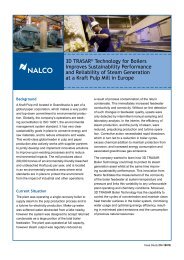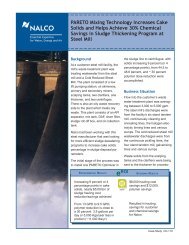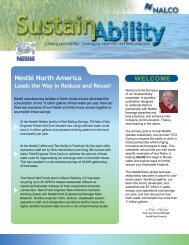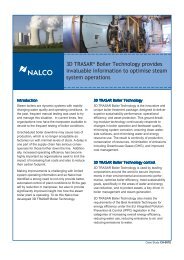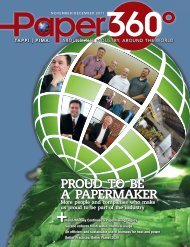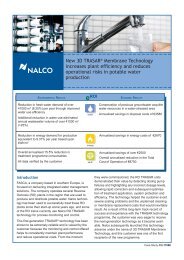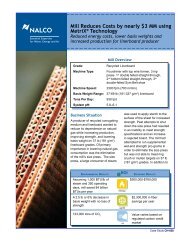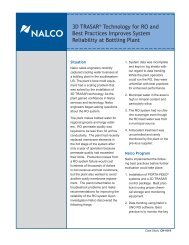R-657.pdf - Nalco
R-657.pdf - Nalco
R-657.pdf - Nalco
Create successful ePaper yourself
Turn your PDF publications into a flip-book with our unique Google optimized e-Paper software.
Managing microbio control<br />
programs Reprint R-657<br />
By Tim Nahley, <strong>Nalco</strong> Company<br />
Microbiological control programs play a key role in<br />
maintaining machine runnability and product quality.<br />
In the December 1995 issue of PIMA Magazine, we<br />
discussed how performance and economics can vary<br />
from mill to mill—even between mills that produce<br />
the same grades. Five key elements influence your results<br />
and bottom line. The elements listed in Figure 1<br />
affect either the growth of microorganisms in paper<br />
machine systems or the development of microbiological<br />
deposits, or both. In the first article, system inoculation—the<br />
first element—was discussed. In this<br />
article, the effects of the remaining four elements will<br />
be reviewed.<br />
Microbiological Growth Requirements—Uncontrolled<br />
paper systems provide an excellent environment<br />
for microorganisms to thrive. These systems<br />
provide the right nutrients, pH and temperature<br />
ranges to support microbiological activity. These<br />
growth requirements differ from mill to mill—even<br />
on identical grades, depending on the way the paper<br />
is made and the machine is operated. Operational<br />
changes can often affect microbiological growth<br />
requirements and ultimately, the overall performance<br />
and economics of the microbiological deposit control<br />
program.<br />
Nutrient loading—The nutrients available in any<br />
particular machine system are the result of several<br />
variables, one being grade structure. The fiber source<br />
will affect microbiological activity through the introduction<br />
of nutrients, particularly in post-consumer<br />
fiber grades. Coated versus uncoated grades can<br />
affect the degree of nutrients, since many coating formulations<br />
contain ingredients bacteria use as food.<br />
Starch is a well known nutrient for increasing microbiological<br />
growth. Changes in the amounts of starch<br />
used for internal or surface sizing or in coating formulations<br />
often influence the results and costs of a<br />
microbiological deposit control program.<br />
The retention program also plays a key role in machine<br />
system nutrient loading. Additives not retained<br />
in the sheet build up in the water and stock systems<br />
of a paper machine. Once there, they become an excellent<br />
media for microbiological growth. Differences<br />
in the performance of a retention program from<br />
Reprinted by permission from PIMA Magazine, December 1995<br />
Key Elements Influencing Performance and Economics<br />
of Microbiological Deposit Control Programs<br />
■ System Inoculation<br />
■ Microbiological Growth Requirements<br />
■ Control Philosophy<br />
■ Mill Design<br />
■ Stock Management & Housekeeping<br />
Figure 1<br />
machine to machine, or fluctuations in retention on<br />
the same machine, will have a major impact on the<br />
microbiological control program.<br />
An increasingly important cause of nutrient loading<br />
in paper mills is closure. As less water is discharged<br />
from paper mills, contaminants in the water begin to<br />
cycle up. Again, nutrients build up as closure increases,<br />
making microbiological control more challenging.<br />
System pH—pH is a critical factor affecting the<br />
growth of microbiological organisms in paper mill<br />
systems. Although microorganisms can live within the<br />
pH range of most papermaking processes (pH 4-8),<br />
the degree of growth will be different within this<br />
range. As pH increases from acid to neutral to alkaline,<br />
the environment becomes more favorable for<br />
vigorous microbiological activity.<br />
System temperature—Temperature also influences<br />
the performance of a microbiological control program.<br />
Generally, as machine temperature increases past<br />
130°F, the activity of many microorganisms begins<br />
to decrease. There are, however, thermophilic bacteria<br />
that can thrive under these conditions.<br />
Oxygen requirements—Oxygen levels not only<br />
affect the metabolism of microorganisms in a machine<br />
system, but also affect the type of organisms present.<br />
This results in the existence of a variety of organisms<br />
over a range of oxygen levels, all requiring a<br />
different approach to treatment. Changes in the
oxygen levels due to factors such as temperature or<br />
machine closure will change the microbial population<br />
of the machine and require different control methods.<br />
Control Philosophy—The method a mill chooses<br />
for microbiological deposit control plays a large role<br />
in the performance and economics of the program.<br />
Whether a mill chooses to use an on-machine oxidizer<br />
(such as chlorine), non-oxidizing biocides, or controls<br />
deposits primarily thorough boilouts and washups<br />
greatly affects results and costs. There are tradeoffs<br />
for each of these methods.<br />
The use of microbiological control chemicals will provide<br />
advantages in machine runnability. Line item<br />
chemical costs, however, can run into dollars per ton.<br />
Minimal use of these agents in conjunction with frequent<br />
boilouts and washups will keep chemical costs<br />
low but at the expense of machine downtime. Total<br />
machine downtime and product quality should be considered<br />
relative to deposit control costs.<br />
Mill Design—One factor seldom considered for its<br />
impact on the performance and economics of a microbiological<br />
deposit control program is mill design.<br />
A survey of 12 alkaline fine paper mills showed a wide<br />
range of results and costs. When analyzed, the mills<br />
with larger machines typically had fewer microbiological<br />
related problems and higher chemical costs<br />
per ton than those with smaller machines. A combination<br />
of the following conditions may be the reason.<br />
The larger mills have larger chests with longer turnover<br />
times. The longer turnover times, particularly<br />
in coated broke silos, can require more biological control<br />
agents. These larger machines were also newer<br />
and had less maintenance-related downtime than the<br />
smaller, older machines. Consequently, the smaller<br />
machines had more opportunities for boilouts and<br />
wash-ups. Finally, the machine time of the larger<br />
machine was more costly, so the machines were kept<br />
cleaner to maximize time between boilouts.<br />
Mill design, particularly cross connections between<br />
machines, is an important consideration. A two<br />
machine mill, one producing food grade products and<br />
one producing boxboard, with a common white water<br />
system, must consider how the performance of the<br />
program on one machine will affect the other.<br />
Headbox and approach piping design and the type of<br />
construction materials can also affect the rate at<br />
which deposition occurs. For instance, open and air<br />
padded headbox designs will typically develop<br />
biofilms faster than a hydraulic headbox design.<br />
Machine speed also plays a role but in this case, it is<br />
Printed in U.S.A. 3-04<br />
the ability of the machine to tolerate deposits that<br />
make it to the sheet that will affect runnability. A<br />
faster machine is less tolerant of sheet deposits and<br />
will develop more breaks than a slower machine.<br />
Stock Management and Housekeeping Practices—Stock<br />
management and housekeeping practices<br />
will affect the efficiency of the microbiological<br />
control program. The way in which stock is stored as<br />
well as housekeeping procedures, such as boilouts and<br />
wash-ups, can differ between mills.<br />
Stock chests can be an area of concern. The consistency<br />
of stock streams in conjunction with chest and<br />
silo design constraints can result in channeling and<br />
dead zones where stock can stagnate, which promotes<br />
microbiological activity. Biological control agents<br />
never reach these areas due to the channeling. As<br />
chest levels rise and fall, this highly contaminated<br />
stock will be transferred to the machine where the<br />
machine microbiological control program can be overwhelmed.<br />
Regarding housekeeping, effective wash-ups at each<br />
opportunity will reduce deposit-related runnability<br />
problems and also the frequency required for boilout.<br />
Proper boilouts will help to minimize chemical<br />
requirements by completely eliminating microbiological<br />
deposits that would serve to reinoculate the system<br />
if not properly removed.<br />
The performance and economics of a microbiological<br />
control program are affected by a<br />
variety of factors. Many of these are in turn<br />
affected by the variables of each papermaking operation.<br />
The variables that have the most significant<br />
impact on the control program include:<br />
• fresh water quality<br />
• fiber source<br />
• additives<br />
• grade structure<br />
• retention program<br />
• mill closure<br />
• operating pH<br />
• operating temperatures<br />
• system & machine design<br />
• stock management practices<br />
• boilout & wash-up practices<br />
To prevent unplanned microbiological-related problems<br />
resulting from operational changes, consult with<br />
your in-house and supplier experts. Taking time to<br />
discuss potential changes in any of the areas on the<br />
potential impact of the microbiological control program<br />
will be time well spent.<br />
<strong>Nalco</strong> Company 1601 West Diehl Road • Naperville, Illinois 60563-1198<br />
SUBSIDIARIES AND AFFILIATES IN PRINCIPAL LOCATIONS AROUND THE WORLD




